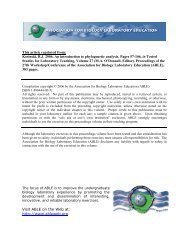A Quantitative Study of Litter and Soil Invertebrates - Association for ...
A Quantitative Study of Litter and Soil Invertebrates - Association for ...
A Quantitative Study of Litter and Soil Invertebrates - Association for ...
You also want an ePaper? Increase the reach of your titles
YUMPU automatically turns print PDFs into web optimized ePapers that Google loves.
80<br />
<strong>Litter</strong> <strong>and</strong> <strong>Soil</strong> <strong>Invertebrates</strong><br />
Notes <strong>for</strong> the Instructor<br />
Preliminary Preparations<br />
Berlese funnel set-ups range in expense from elaborate custom-built multiple units, with<br />
provision <strong>for</strong> control <strong>of</strong> room <strong>and</strong> funnel temperature <strong>and</strong> rheostatic control <strong>of</strong> wattage output in<br />
each funnel, to make-shift funnels fashioned from cardboard or aluminum foil <strong>and</strong> light from a<br />
table lamp. For the funnel to successfully extract animals from the sample the three gradients<br />
mentioned in the Student Outline (light-dark, warm-cool, humid-dry) must be produced. The time<br />
<strong>and</strong> expense one expends to invest in fabricating the apparatus to produce these gradients is up to<br />
the instructor. Intermediate in expense <strong>and</strong> ef<strong>for</strong>t involved is the set <strong>of</strong> four funnels I use<br />
(Figure 4.1). This set-up is portable <strong>and</strong> may be dismantled <strong>and</strong> stored compactly. Six such sets<br />
will accommodate a class <strong>of</strong> 24 students so that each group has the opportunity to do all steps in<br />
the analysis: obtain sample, process it in the funnel, <strong>and</strong> analyze it via microscopic examination.<br />
Since 3–5 days are needed <strong>for</strong> processing, the sample is obtained during part <strong>of</strong> one laboratory<br />
period <strong>and</strong> analysis is completed in the second period.<br />
Attention may be drawn to several aspects <strong>of</strong> design <strong>and</strong> construction. The funnel can be <strong>of</strong><br />
any material but the internal surface should be smooth. It is better if it is painted black <strong>for</strong><br />
purposes <strong>of</strong> facilitating the light-dark gradient <strong>and</strong> sealing the surface <strong>for</strong> h<strong>and</strong>ling the moisture <strong>of</strong><br />
the sample. Three tabs positioned approximately two-thirds the distance from the small to the<br />
large end <strong>of</strong> the funnel provide support <strong>for</strong> a removable shelf <strong>of</strong> hardware cloth <strong>for</strong> supporting the<br />
sample. Use a 1/4" mesh hardware cloth disc <strong>and</strong> add on smaller meshes if the sample particles<br />
are particularly fine (see Figure 4.1). A small mesh size may limit the passage <strong>of</strong> larger animals;<br />
to accommodate this <strong>and</strong> a fine sample, use the 1/4" mesh disc <strong>and</strong> add smaller area discs or<br />
squares <strong>of</strong> finer mesh. Pile the fine material on these areas. Always leave at least one small area<br />
<strong>of</strong> larger mesh uncovered by sample so larger, more ambulatory animals like beetles <strong>and</strong> spiders<br />
can find a way downward.<br />
The funnels in Figure 4.1 were made <strong>of</strong> galvanized metal by a local sheet-metal fabricator.<br />
The pattern <strong>and</strong> size <strong>for</strong> this funnel are seen in Figure 4.2 in which the squares are 1" on a side.<br />
The larger, upper opening <strong>of</strong> the funnel is 11 1/2" in diameter <strong>and</strong> supports the light-reflector unit<br />
whose diameter is 12 1/2". The lower opening is 1" <strong>and</strong> fits conveniently into a number <strong>of</strong> styles<br />
<strong>of</strong> collecting bottles. Overlap along the straight margins <strong>of</strong> the funnel is 1" <strong>and</strong> is riveted to make<br />
a tight seam.<br />
The socket holding the 25- or 40-watt light bulb should have its own on-<strong>of</strong>f switch <strong>for</strong><br />
convenience in control <strong>of</strong> a set <strong>of</strong> funnels. The light-reflector unit may be composed <strong>of</strong> a socket<br />
with threads that fit into the reflector or into a circular bracket which attaches to the reflector via<br />
three adjustable thumbscrews (Figure 4.1). The latter is slightly preferred because it allows<br />
greater flexibility in bulb wattage by providing a small heat <strong>and</strong> air vent space in the bracket.<br />
The frame support <strong>for</strong> the funnels shown in Figure 4.1 is <strong>of</strong> 1/2" plywood <strong>and</strong> 1" x 1" wood<br />
strips; the top <strong>and</strong> bottom shelves have wood strips attached at three sides by nails. The two end<br />
panels attach to the shelves by screws into the wood strips. Removal <strong>of</strong> the screws disengages the<br />
four pieces <strong>of</strong> the frame <strong>and</strong> allows compact storage. The end panels measure 28" × 16". The<br />
shelves are 16" × 50 1/2". Holes <strong>for</strong> the funnels in the top shelf are 9 3/4" in diameter. The<br />
centers <strong>for</strong> the four holes are located along a line 8" from the front edge <strong>and</strong> successively 6 1/2",<br />
19", 31 1/2", <strong>and</strong> 44" from one end. The vertical stability <strong>of</strong> the funnels is increased if the holes in<br />
the top shelf are cut with a bevel which approximates the angle <strong>of</strong> the funnel which it receives.<br />
Stability <strong>of</strong> the entire frame is greatly enhanced by the attachment, with screws, <strong>of</strong> a plywood<br />
panel, 16" × 18" to the back margin <strong>of</strong> the two shelves. The bottom shelf is attached to the end<br />
panels so that the upper surface is 10 1/2" above the lower border <strong>of</strong> the panels.
















